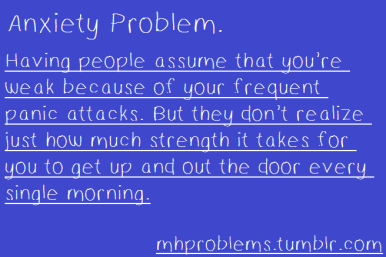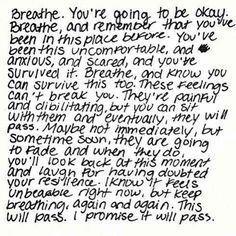
Everybody knows what it’s like to feel anxious, the butterflies in your stomach before a first date, the tension you feel when you start a new job, the way your heart pounds if you’re in danger. Anxiety rouses you to action. It gears you up to face a threatening situation. It makes you study harder for that exam, and keeps you on your toes when you’re making a speech. In general, it helps you cope.
But if you have an anxiety disorder, this normally helpful emotion can do just the opposite, it can keep you from coping and can disrupt your daily life. Anxiety disorders aren’t just a case of “nerves.” They are illnesses, often related to the biological makeup and life experiences of the individual, and they frequently run in families. There are several types of anxiety disorders, each with its own distinct features.
An anxiety disorder may make you feel anxious most of the time, without any apparent reason. Or the anxious feelings may be so uncomfortable that to avoid them you may stop some everyday activities. Or you may have occasional bouts of anxiety so intense they terrify and immobilize you.
Anxiety tricks you to experience Discomfort, and get fooled into treating it like Danger.
What do we do when we’re in danger? We only have three things: Fight, Flight, and Freeze. If it looks weaker than me, I’ll fight it. If it looks stronger than me, but slower, I’ll run away. And if it looks stronger and faster than me, I’ll freeze and hope it doesn’t see so good. That’s all we have for danger.
When people experience the fear of a panic attack, or a phobic encounter, or an obsessive thought, they instinctively treat it as a danger. They try to protect themselves, with some variation of Fight, Flight, or Freeze.
Many people misunderstand these disorders and think individuals should be able to overcome the symptoms by sheer willpower. Wishing the symptoms away does not work–but there are treatments that can help.
How can you overcome the anxiety trick?
If you come to see that you’ve been putting out fires with gasoline, you may not have any idea what to do next. But the first step is always the same: put down the buckets. Stop throwing gasoline on that fire.
This is where the cognitive behavioral methods of desensitization and exposure come in. They’re intended as methods by which you can practice with (not against) the symptoms, and become less sensitive to them. As you lose your fear of the symptoms, through this practice, that’s when the symptoms will fade.
All too often, people get the idea that exposure means going to a place or situation where you’re likely to get anxious, perhaps a highway or an elevator, and take a ride without getting anxious. That’s not the point! The point is to actually go there and feel the anxiety, being sure to stay there and letting the anxiety leave first.
The way to disarm the Anxiety Trick is to increasingly spend time with anxiety, to expose yourself to the thoughts and sensations, and allow them to subside over time.
What can you do to make the experience of exposure more tolerable? You can use the AWARE steps as a general guide for how to conduct yourself while doing exposure.
The five steps to overcoming panic attacks are:
Acknowledge & Accept
Wait & Watch (and maybe, Work)
Actions (to make myself more comfortable)
Repeat
End
For more information on this topic:
http://overcomingyouranxiety.net/resources/dr-claire-weekes-hope-and-help-for-your-nerves/





